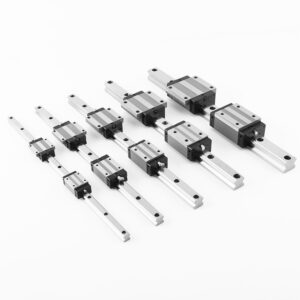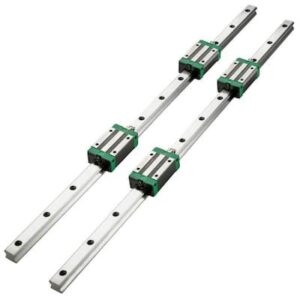Introduction
Slide rail linear systems, commonly referred to as linear slide rails or linear guide rails, are essential components in modern machinery, robotics, industrial automation, and precision equipment. They provide reliable and smooth linear motion, supporting heavy loads while ensuring high accuracy and repeatability. The ability to convert rotational motion into precise linear movement makes these systems indispensable in applications ranging from CNC machines and 3D printers to medical devices and semiconductor equipment.
This comprehensive guide covers all aspects of slide rail linear systems, including design principles, types, materials, mechanics, industrial applications, installation, maintenance, troubleshooting, and emerging trends. It is aimed at engineers, designers, and professionals seeking a deep understanding of linear slide rail technology.
Table of Contents
What Are Slide Rail Linear Systems?
Components of a Linear Slide Rail System
Types of Slide Rail Linear Systems
Mechanics and Design Principles
Materials Used in Linear Slide Rails
Advantages of Slide Rail Linear Systems
Industrial Applications
How to Select the Right Slide Rail Linear System
Installation and Alignment Techniques
Maintenance and Lubrication
Common Problems and Troubleshooting
Emerging Innovations and Trends
Frequently Asked Questions (FAQs)
Conclusion
1. What Are Slide Rail Linear Systems?
Slide rail linear systems are mechanical devices designed to provide smooth, precise linear motion for machinery components. They consist of a rail and a moving carriage or block, which travels along the rail while supporting loads. Unlike simple sliding mechanisms, slide rails reduce friction using rolling elements such as balls or rollers, or low-friction sliding surfaces. This ensures stable, high-precision movement, even under heavy loads.
Slide rail linear systems are used wherever controlled, repeatable linear motion is critical, including manufacturing equipment, laboratory automation, robotic assembly, medical devices, and aerospace machinery.
2. Components of a Linear Slide Rail System
A typical slide rail linear system consists of the following components:
2.1 Rail
The rail acts as the guide path for the moving carriage. Rails are precision-ground and often hardened to resist wear, maintain alignment, and minimize deflection.
2.2 Carriage or Slider Block
The carriage moves along the rail and carries the load. It incorporates rolling elements or low-friction surfaces, and may include lubrication channels, end caps, or protective covers.
2.3 Rolling Elements
Balls or cylindrical rollers reduce friction between the carriage and rail. Recirculating designs allow continuous movement without interruption.
2.4 End Caps and Covers
End caps prevent rolling elements from escaping and protect the system from dust, debris, and contaminants.
2.5 Lubrication Features
Lubrication channels, reservoirs, or wicks are integrated to maintain smooth motion and extend service life.
3. Types of Slide Rail Linear Systems
Linear slide rails are available in various types to accommodate different load capacities, precision requirements, and environmental conditions:
3.1 Ball-Type Slide Rails
Design: Uses recirculating balls to reduce friction.
Applications: CNC machines, 3D printers, automation systems.
Advantages: Smooth motion, moderate load capacity, high precision.
3.2 Roller-Type Slide Rails
Design: Cylindrical or needle rollers distribute load over a larger area.
Applications: Heavy industrial machinery, presses, assembly lines.
Advantages: High load capacity, long service life, stable motion.
3.3 Cross-Roller Slide Rails
Design: Rollers arranged in a cross pattern handle multi-directional loads.
Applications: Precision robotics, medical devices, inspection systems.
Advantages: Handles radial, axial, and moment loads simultaneously.
3.4 Miniature Linear Slide Rails
Design: Compact rails for small-scale applications.
Applications: Laboratory instruments, compact automation devices.
Advantages: High precision in limited spaces, lightweight design.
3.5 Plain Slide Rails
Design: Low-friction sliding surfaces without rolling elements.
Applications: Light machinery, slow-speed operations.
Advantages: Simple, cost-effective, minimal maintenance.
4. Mechanics and Design Principles
4.1 Load Distribution
Slide rail linear systems are engineered to distribute loads evenly across rolling elements or sliding surfaces. This reduces wear and ensures long-term reliability.
4.2 Friction Reduction
Rolling elements or low-friction coatings reduce energy loss, heat generation, and wear, enabling smooth motion.
4.3 Rigidity and Accuracy
High-quality slide rails maintain structural rigidity under heavy loads, ensuring precise positioning and minimal deflection.
4.4 Recirculation Mechanism
In ball-type and roller-type slide rails, recirculating elements provide continuous motion and prevent interruption, allowing long travel distances.
4.5 Preload
Preload eliminates clearance between the carriage and rail, improving stiffness, reducing vibration, and increasing positional accuracy.
5. Materials Used in Linear Slide Rails
5.1 Hardened Steel
Offers excellent strength and wear resistance, suitable for heavy-duty industrial applications.
5.2 Stainless Steel
Provides corrosion resistance for humid, wet, or chemically aggressive environments while maintaining high strength.
5.3 Aluminum
Lightweight and corrosion-resistant, ideal for portable machinery or aerospace applications.
5.4 Polymers and Composites
Used for cages, seals, and coatings to reduce noise, friction, and maintenance requirements.
6. Advantages of Slide Rail Linear Systems
Precision: High positional accuracy for automated and CNC equipment.
Smooth Motion: Minimal friction and vibration ensure stable performance.
High Load Capacity: Can handle axial, radial, and moment loads effectively.
Durability: Long service life with proper care.
Versatility: Applicable in industrial, robotic, medical, and aerospace sectors.
Noise Reduction: Quiet operation due to rolling elements or low-friction coatings.
7. Industrial Applications
7.1 CNC Machines
Slide rails provide smooth, precise movement of cutting heads, milling tables, and engraving systems.
7.2 Robotics
Enable accurate linear motion of robotic arms, pick-and-place machines, and automated assembly systems.
7.3 Industrial Automation
Used in conveyors, inspection systems, and production lines for repeatable linear motion.
7.4 Medical Equipment
Support linear motion in imaging systems, surgical robots, and laboratory automation devices.
7.5 Semiconductor Manufacturing
Critical for precise wafer handling, assembly, and inspection processes.
7.6 Aerospace and Defense
Ensure precise positioning in simulators, satellite mechanisms, and instrumentation.
8. How to Select the Right Slide Rail Linear System
Consider the following factors:
Load Requirements: Ensure compatibility with static and dynamic loads.
Precision: Assess the required positional accuracy and repeatability.
Speed: Choose a rail capable of operating at desired speeds.
Environment: Consider temperature, humidity, dust, and contaminants.
Space Limitations: Match rail and carriage size to system constraints.
Maintenance: Evaluate lubrication and accessibility needs.
9. Installation and Alignment Techniques
9.1 Surface Preparation
Mounting surfaces must be flat, rigid, and free from debris to prevent misalignment.
9.2 Rail Alignment
Rails must be parallel and straight; misalignment increases friction and reduces accuracy.
9.3 Mounting
Use proper fasteners and torque specifications to avoid rail deformation.
9.4 Testing
Conduct load and motion tests to verify smooth travel and precision.
10. Maintenance and Lubrication
Cleaning: Remove dust, debris, and contaminants regularly.
Lubrication: Apply grease or oil according to manufacturer recommendations.
Inspection: Monitor wear, corrosion, and damage to maintain performance.
Replacement: Replace worn or damaged components promptly.
11. Common Problems and Troubleshooting
Noise or Vibration: Caused by misalignment, debris, or insufficient lubrication.
Sticking or Jamming: Check for bent rails, damaged rolling elements, or foreign particles.
Excessive Wear: Resulting from overloading, poor lubrication, or contamination.
Corrosion: Stainless steel or coated rails should be used in humid or chemically aggressive environments.
12. Emerging Innovations and Trends
High-Speed Slide Rails: Optimized for ultra-fast production equipment.
Miniaturized Linear Rails: Compact guides for precision devices and small automation systems.
Integrated Sensors: Real-time monitoring of position, load, and temperature.
Advanced Materials: Ceramics, coatings, and polymers reduce friction and extend service life.
Predictive Maintenance: IoT-enabled rails allow early detection of wear and operational issues.
13. Frequently Asked Questions (FAQs)
Q1: How do slide rail linear systems differ from traditional bearings?
A1: Slide rails provide precise linear motion with rolling or low-friction surfaces, whereas traditional bearings are designed mainly for rotational motion.
Q2: Can slide rails be used outdoors?
A2: Yes, stainless steel or corrosion-resistant coatings allow operation in outdoor and humid environments.
Q3: How often should slide rail linear systems be lubricated?
A3: Depending on load and operating conditions, lubrication intervals may range from weekly to monthly.
Q4: What is the expected lifespan of a linear slide rail system?
A4: With proper maintenance, slide rails can last several years, even under heavy-duty conditions.




